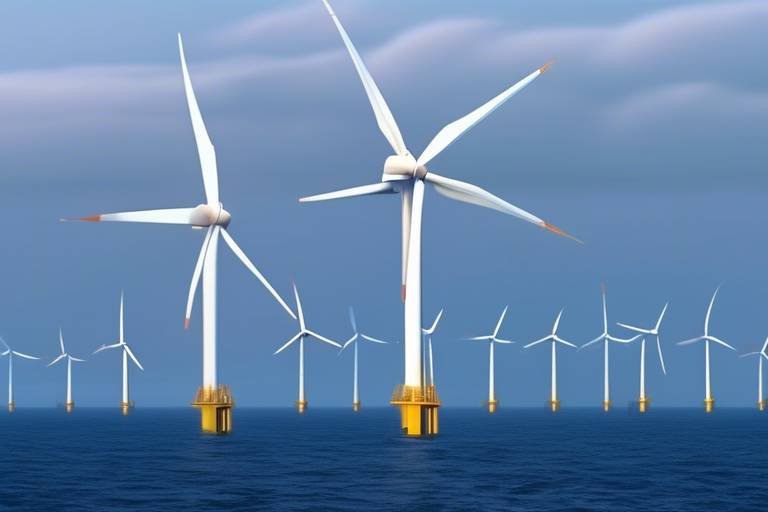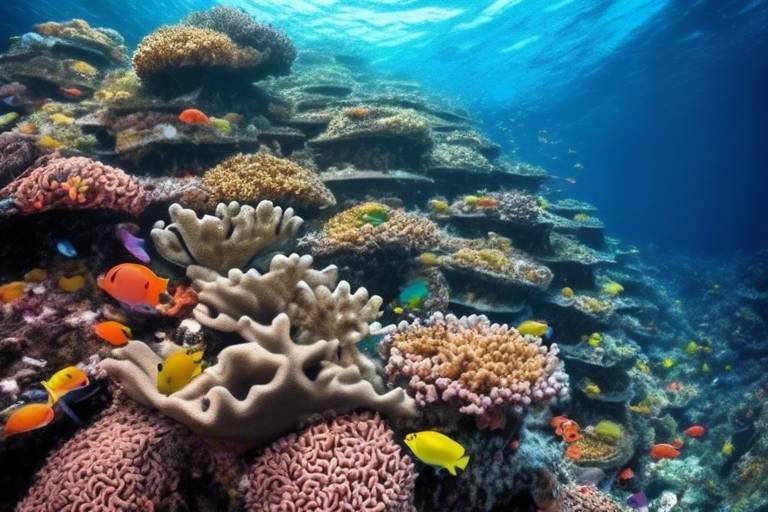The Impact of Climate Change on the Skiing Industry
Climate change is no longer a distant threat; it’s a reality that’s reshaping industries across the globe, and the skiing industry is no exception. With rising temperatures and shifting weather patterns, ski resorts are finding themselves in a precarious position. Imagine a world where the thrill of carving through fresh powder is replaced by the disappointment of brown slopes and bare patches. This article dives deep into how climate change is not just affecting snow conditions but also the very economic viability of ski resorts and the communities that depend on them.
Climate change is altering snowfall patterns, leading to inconsistent snow seasons. Ski resorts are now grappling with the unpredictability of weather, making it a challenge to maintain operations and profitability. Picture this: one winter, the slopes are blanketed in snow, drawing in crowds of eager skiers, while the next season, they’re left scrambling to make ends meet due to insufficient natural snowfall. This inconsistency forces resorts to invest heavily in snow-making technologies, which, while helpful, come with their own set of challenges. The reliance on artificial snow raises questions about sustainability and the long-term viability of the skiing experience.
The skiing industry faces significant economic challenges due to climate change. As snowfall decreases, visitor numbers dwindle, leading to revenue losses that can cripple local economies. Towns that once thrived on winter tourism are now left grappling with the harsh reality of fewer visitors. The impact is not just felt in the ski resorts but also in local businesses that rely on the influx of tourists. Restaurants, hotels, and shops that once flourished during the ski season are now experiencing a downturn, leading to a ripple effect that can devastate entire communities.
Job security in the skiing industry is at risk as resorts struggle to maintain profitability. Many seasonal employment opportunities may diminish, affecting local workers who depend on winter sports for their livelihoods. Imagine a ski instructor who has spent years honing their skills, only to find that there are fewer jobs available due to dwindling visitor numbers. This situation not only affects individuals but also the broader community, leading to increased unemployment and economic instability.
Some ski resorts may face permanent closures due to unviable conditions. As the climate continues to change, the feasibility of operating certain resorts becomes questionable. This trend can lead to a decline in tourism and economic activity, further stressing local communities reliant on the skiing industry. When a beloved ski resort closes its doors, it’s not just a loss of a recreational space; it’s the loss of a community hub, a place where memories are made, and families bond over shared experiences.
To combat climate challenges, ski resorts are investing in advanced snow-making technologies. These innovations aim to ensure a consistent skiing experience, but they come with high operational costs and environmental considerations. While snow-making machines can provide a temporary solution, they often require significant energy and water resources, raising concerns about their sustainability. The balance between providing a good skiing experience and maintaining environmental integrity is a tightrope walk that many resorts are now navigating.
The environmental consequences of skiing, exacerbated by climate change, include habitat disruption and increased carbon emissions. The industry must balance recreational needs with sustainable practices to mitigate these effects. Skiing, while a beloved pastime, can take a toll on the environment, from the construction of resorts to the energy used in snow-making. As awareness grows, many resorts are beginning to embrace eco-friendly practices, but the path to sustainability is fraught with challenges.
Ski resorts are adopting various adaptive strategies to cope with climate change. These include diversifying activities, enhancing snow-making capabilities, and promoting sustainability initiatives to attract eco-conscious visitors. By broadening their appeal beyond just skiing, resorts can create year-round destinations that draw in visitors regardless of snow conditions. This adaptability is crucial for survival in an ever-changing climate.
To maintain visitor interest during low-snow seasons, resorts are developing alternative activities like mountain biking and hiking. This diversification helps sustain revenue and encourages year-round tourism. Imagine a ski resort transforming into a vibrant hub for mountain biking enthusiasts in the summer months, providing a much-needed boost to the local economy. By offering a variety of activities, resorts can keep their doors open, even when the snow isn’t cooperating.
Many ski resorts are implementing sustainability initiatives, such as renewable energy sources and waste reduction programs. These efforts aim to reduce the industry's carbon footprint and promote environmental stewardship among visitors. Resorts are beginning to recognize that their future depends on their ability to operate sustainably, and many are taking significant steps to ensure they leave a positive impact on the environment.
- How is climate change affecting snowfall? Climate change leads to warmer temperatures, resulting in less snowfall and inconsistent snow seasons.
- What economic impact does reduced snowfall have on ski resorts? Reduced snowfall leads to fewer visitors, resulting in significant revenue losses for resorts and local businesses.
- Are ski resorts closing due to climate change? Yes, some resorts may face permanent closures if conditions become unviable for skiing.
- What technologies are being used to combat climate change in skiing? Resorts are investing in advanced snow-making technologies to ensure a consistent skiing experience.
- How are ski resorts promoting sustainability? Many resorts are adopting renewable energy sources and waste reduction programs to decrease their environmental impact.

[Changing Snow Patterns]
Climate change is not just a buzzword; it's a reality that is reshaping the world, and the skiing industry is no exception. Traditionally, ski resorts relied on predictable snowfall patterns to ensure a steady flow of visitors each winter. However, as the climate warms, we are witnessing a dramatic shift in these patterns, leading to inconsistent snow seasons. This inconsistency poses a significant challenge for ski resorts, which must adapt quickly to unpredictable weather conditions. Imagine planning a ski trip, only to find that the slopes are bare or the snow is slushy instead of powdery. This is becoming an all-too-common scenario.
One of the most alarming trends is the decrease in overall snowfall during critical winter months. According to recent studies, many regions are experiencing shorter winters, with snowfall levels dropping significantly. For instance, a report from the National Oceanic and Atmospheric Administration (NOAA) indicates that some areas in the Northeast U.S. have seen a reduction of up to 50% in snowfall over the last few decades. This decline not only affects the quality of skiing but also the overall experience for visitors who come to enjoy winter sports.
To combat these challenges, ski resorts are increasingly investing in snow-making technologies. These machines can create artificial snow, allowing resorts to maintain their operations even when natural snowfall is lacking. However, this comes at a cost—both financially and environmentally. The energy required to produce artificial snow can lead to increased carbon emissions, further contributing to the very problem these resorts are trying to mitigate. Resorts are left in a dilemma: invest in technology to ensure snow coverage and risk environmental damage, or face the reality of dwindling visitor numbers.
Moreover, the changing climate is also affecting the timing of snowfall. Ski seasons are becoming shorter, with some resorts opening later and closing earlier than in previous years. This shift not only impacts the financial viability of these businesses but also the livelihoods of those who depend on winter tourism. The unpredictable nature of snowfall has forced resorts to rethink their strategies, leading to a focus on year-round attractions to keep visitors coming, regardless of the snow conditions.
In summary, the changing snow patterns due to climate change present a complex challenge for the skiing industry. As resorts grapple with the realities of inconsistent snowfall and the associated economic pressures, they must innovate and adapt to survive. The future of skiing may depend on how effectively these resorts can navigate the unpredictable landscape of winter weather.

[Economic Consequences]
Climate change is not just a buzzword; it's a reality that is profoundly reshaping the skiing industry, and the economic consequences are staggering. As snowfall becomes increasingly unpredictable, ski resorts are facing a decline in visitor numbers, which directly translates to lower revenues. Imagine planning a winter getaway, only to find that the slopes are bare or the conditions are less than ideal. This inconsistency can deter even the most devoted ski enthusiasts, leading to a ripple effect that impacts not just the resorts but the entire local economy.
Many communities that thrive on winter tourism find themselves in a precarious position. When the snow doesn't fall as expected, the local businesses that depend on ski season—like hotels, restaurants, and rental shops—begin to feel the pinch. For instance, a ski resort that typically attracts thousands of visitors during peak season may see a dramatic drop in foot traffic, leading to significant revenue losses. This isn't just a seasonal hiccup; it can have long-term effects on the economic stability of these towns.
To illustrate the potential impact, consider the following table that highlights the economic dependency of various towns on skiing:
| Town | Percentage of Revenue from Skiing | Estimated Job Losses (if ski season fails) |
|---|---|---|
| Aspen | 60% | 200+ |
| Jackson Hole | 70% | 150+ |
| Park City | 50% | 100+ |
This table underscores the vulnerability of these towns and their economies. When ski resorts struggle, the consequences extend beyond the slopes. Local workers, many of whom rely on seasonal jobs, face uncertainty. As resorts grapple with the financial strain, they may cut back on staff or, worse, close altogether. The job security of ski instructors, lift operators, and hospitality staff hangs in the balance, creating a ripple effect that can devastate communities.
Moreover, the economic ramifications of climate change extend beyond immediate job losses. As resorts invest in snow-making technologies to combat diminishing snowfall, they are also incurring substantial operational costs. These investments, while necessary, can lead to increased prices for lift tickets and services, which might deter visitors even further. It's a vicious cycle: rising costs lead to fewer visitors, which in turn leads to more financial strain on the resorts.
In conclusion, the economic consequences of climate change on the skiing industry are profound and far-reaching. As the industry grapples with these challenges, it becomes increasingly clear that adaptation and innovation are essential. The question remains: will the skiing industry be able to pivot and thrive in a warming world, or will it become a relic of the past?
- How does climate change affect snowfall? Climate change leads to warmer temperatures, which can result in less snowfall and more rain during winter months.
- What are ski resorts doing to adapt? Many resorts are investing in snow-making technologies and diversifying their offerings to include summer activities.
- How does this impact local economies? Reduced snowfall leads to lower visitor numbers, which can significantly affect local businesses and employment rates.

[Impact on Employment]
The skiing industry is not just about the thrill of gliding down snow-covered slopes; it's also a lifeline for many communities that depend on it for economic stability. However, as climate change wreaks havoc on snow conditions, the job security of those working in this sector is increasingly at risk. The inconsistency in snowfall leads to unpredictable seasons, which can significantly affect the profitability of ski resorts. When resorts struggle to attract visitors due to poor snow conditions, the repercussions ripple through the entire community.
Imagine a bustling ski town, full of life and energy during winter, where local businesses thrive on the influx of tourists. Now picture that same town during a season with little to no snow. The shops close, restaurants see fewer customers, and the vibrant atmosphere fades. This scenario is becoming all too common, as resorts are forced to cut back on their staff to stay afloat. Seasonal employment opportunities, which are crucial for many locals, may diminish, leaving workers scrambling for alternative sources of income.
According to recent studies, ski resorts have reported a 30% decrease in seasonal hires over the past decade due to unpredictable weather patterns. This decline not only affects full-time employees but also impacts part-time workers, instructors, and seasonal staff who rely on winter jobs to support their families. The loss of these jobs can lead to increased unemployment rates in areas that are already economically vulnerable, creating a cycle of hardship that is difficult to break.
Furthermore, the threat of resort closures looms large. If a ski resort cannot provide a reliable skiing experience, it may be forced to shut its doors permanently. This not only means the loss of jobs for those directly employed but also a decline in tourism-related jobs in the surrounding area. The economic impact can be staggering, leading to a significant downturn in local economies that are heavily reliant on winter sports.
In response to these challenges, some resorts are beginning to explore alternatives to traditional skiing jobs. For example, they are diversifying their offerings to include summer activities such as mountain biking, zip-lining, and hiking. By expanding their seasonal operations, resorts can create new job opportunities and keep local economies buoyant throughout the year. However, this shift requires investment in new infrastructure and training, which can be a daunting task for many resorts facing financial strain.
Ultimately, the impact of climate change on employment in the skiing industry is profound and multifaceted. It calls for a collective effort from resort owners, local governments, and communities to adapt to changing conditions while ensuring that workers are not left behind. The future of skiing may depend on how well we can navigate these challenges, balancing the need for economic viability with the imperative of environmental sustainability.
- How is climate change affecting snowfall?
Climate change leads to warmer temperatures, resulting in less snowfall and shorter ski seasons. - What are the economic impacts of reduced snowfall?
Reduced snowfall leads to fewer visitors, resulting in decreased revenue for ski resorts and local businesses. - What alternative jobs are being created in the skiing industry?
Resorts are diversifying their activities, creating jobs in areas like mountain biking and summer tourism. - How can ski resorts adapt to climate change?
By investing in snow-making technology, diversifying activities, and implementing sustainability initiatives.

[Resort Closures]
The looming threat of climate change has sparked a wave of concern within the skiing community, as many ski resorts face the grim reality of potential closures. With the changing climate leading to less reliable snowfall, some resorts are finding it increasingly difficult to maintain viable operations. Imagine a once-thriving ski destination, bustling with eager skiers, now standing eerily quiet, its slopes barren and lifeless. This scenario is becoming all too common, forcing resort owners and local communities to confront the harsh truth: if temperatures continue to rise, some resorts may never reopen their doors.
As snowfall becomes more inconsistent, the financial implications are severe. Resorts that once boasted a steady influx of visitors are now struggling to attract guests during what should be their peak season. This decline in business not only affects the resorts themselves but also has a ripple effect on local economies that rely heavily on winter tourism. Restaurants, shops, and hotels that cater to skiers face dwindling revenue, which can lead to layoffs and even permanent closures. In fact, a recent study indicated that up to 30% of ski resorts in certain regions could face closure in the coming decades if trends continue.
Moreover, the emotional toll on communities can be profound. Skiing is not just a recreational activity; it is a way of life for many. The prospect of losing a beloved local resort can feel like losing a piece of one's identity. To illustrate this point, consider a small town that has built its entire economy around a single ski resort. As the resort struggles to stay afloat, the community's spirit and livelihood are threatened. The once vibrant atmosphere of winter festivities can quickly turn into a somber reminder of what was lost.
In response to these challenges, some resorts are exploring creative solutions to remain operational. This includes investing in snow-making technology and diversifying their offerings to attract visitors year-round. For instance, many resorts are starting to embrace summer activities such as mountain biking, hiking, and even festivals that draw in crowds during the off-season. While these measures can help alleviate some financial pressures, they also come with their own set of challenges, including high operational costs and the need for significant investment.
Ultimately, the future of ski resorts hangs in a delicate balance. The decisions made today will determine whether these cherished winter destinations can survive the onslaught of climate change. The question remains: can the skiing industry adapt swiftly enough to ensure that future generations can enjoy the thrill of gliding down snow-covered slopes? Only time will tell, but the urgency to act has never been greater.
- What factors are causing ski resort closures?
Climate change, leading to inconsistent snowfall and rising temperatures, is the primary factor affecting ski resort viability. - How are resorts adapting to climate change?
Many resorts are investing in snow-making technologies and diversifying their activities to attract visitors year-round. - What impact do resort closures have on local economies?
Resort closures can lead to significant economic downturns in communities that rely heavily on winter tourism, affecting local businesses and employment. - Are there any successful examples of resorts adapting?
Some resorts have successfully integrated summer activities and sustainability initiatives to maintain revenue and attract eco-conscious visitors.

[Investment in Technology]
As the impact of climate change becomes increasingly evident, ski resorts are finding themselves at a crossroads, where the investment in technology is not just a luxury but a necessity. The unpredictable weather patterns and inconsistent snowfall have forced these resorts to rethink their operational strategies. One of the most significant adaptations is the enhancement of snow-making technologies. These advanced systems allow resorts to produce artificial snow, ensuring that ski slopes remain open even when Mother Nature doesn't cooperate.
However, the transition to these high-tech solutions is not without its challenges. The initial cost of installing and maintaining snow-making equipment can be substantial. Resorts must weigh the potential benefits against the financial burden. For instance, a typical snow-making system can cost anywhere from $500,000 to over $1 million, depending on the size of the resort and the technology used. This investment can be daunting, especially for smaller ski areas that operate on tight budgets.
Moreover, while artificial snow can help maintain the skiing experience, it also raises questions about environmental sustainability. The production of snow requires significant amounts of water and energy, which can strain local resources. Resorts must therefore balance the need for technology with their commitment to preserving the natural environment. Innovative solutions, such as using renewable energy sources to power snow-making operations, are gaining traction. This not only helps reduce carbon emissions but also aligns with the growing trend of eco-conscious tourism.
In addition to snow-making, resorts are investing in other technologies to enhance the overall skiing experience. For example, smart technology is revolutionizing how resorts manage their operations. From real-time data analytics that track weather conditions to mobile apps that provide skiers with updates on lift lines and trail conditions, technology is making the skiing experience more enjoyable and efficient.
As we look towards the future, the question remains: will these technological investments be enough to save the skiing industry from the grips of climate change? While the answer is still uncertain, one thing is clear: embracing technology is a step in the right direction. By leveraging innovation, ski resorts can not only survive but potentially thrive in an ever-changing climate.
- How does climate change affect snowfall?
Climate change leads to warmer temperatures, which can result in less snowfall and shorter ski seasons. - What are ski resorts doing to adapt?
Many resorts are investing in advanced snow-making technology and diversifying their activities to attract visitors year-round. - Is artificial snow environmentally friendly?
While it helps maintain skiing conditions, the production of artificial snow requires substantial water and energy, raising sustainability concerns. - What are some alternative activities ski resorts are offering?
Many resorts are now offering activities like mountain biking, hiking, and other outdoor adventures to attract visitors during low-snow periods.

[Environmental Impact]
The skiing industry, while providing thrilling experiences and breathtaking views, has a significant environmental footprint that is becoming increasingly problematic in the face of climate change. As temperatures rise and weather patterns shift, the implications for the natural environment are profound. Ski resorts often require vast amounts of water and energy to produce artificial snow, which can lead to habitat disruption and increased carbon emissions. This not only affects the local wildlife but also contributes to the broader issue of climate change, creating a vicious cycle that threatens the very conditions necessary for skiing.
Moreover, the construction and expansion of ski resorts can result in deforestation and soil erosion, which further exacerbates the environmental crisis. The clearing of land for ski runs and infrastructure can lead to a loss of biodiversity, disrupting ecosystems that have thrived for centuries. As the demand for skiing grows, the pressure on natural resources intensifies, making it crucial for the industry to find a balance between recreation and sustainability.
To illustrate the impact of skiing on the environment, consider the following table that summarizes some of the key environmental concerns associated with the industry:
| Environmental Concern | Description |
|---|---|
| Water Usage | High consumption of water for snow-making can deplete local water sources. |
| Carbon Emissions | Increased energy use for snow-making and resort operations contributes to greenhouse gas emissions. |
| Habitat Disruption | Construction of ski resorts can destroy habitats and displace wildlife. |
| Soil Erosion | Deforestation and land alteration can lead to soil degradation and erosion. |
As the skiing industry grapples with these environmental challenges, it is evident that a shift towards more sustainable practices is not just beneficial but essential. Resorts are beginning to recognize the importance of environmental stewardship and are implementing measures to mitigate their impact. This includes investing in renewable energy sources, improving waste management systems, and promoting eco-friendly transportation options for visitors.
Ultimately, the skiing industry must adapt to the realities of climate change, not only to preserve the sport but also to safeguard the environment. By embracing sustainability, ski resorts can not only reduce their ecological footprint but also attract a growing number of eco-conscious tourists who are eager to enjoy the mountains responsibly. The future of skiing may depend on how well the industry can balance its recreational needs with the urgent call for environmental protection.
- What are the main environmental issues caused by skiing? The main issues include high water usage for snow-making, increased carbon emissions, habitat disruption, and soil erosion.
- How are ski resorts addressing climate change? Many resorts are investing in renewable energy, enhancing waste management, and promoting sustainable practices to mitigate their environmental impact.
- Can skiing be sustainable? Yes, with the right practices in place, skiing can be made more sustainable, allowing for both enjoyment and environmental protection.

[Adaptive Strategies]
As the skiing industry grapples with the undeniable effects of climate change, resorts are not just sitting back and watching the snow melt away. Instead, they are actively adapting to the changing landscape with a variety of innovative strategies. This adaptability is crucial for survival in an industry that has traditionally relied on predictable snowfall and winter conditions. One of the most significant shifts is the move towards diversification of activities offered at ski resorts. By introducing options like mountain biking, hiking, and even summer festivals, resorts are ensuring that they remain attractive destinations year-round, rather than just during the winter season.
Moreover, enhancing snow-making capabilities has become a priority. Many resorts are investing heavily in advanced snow-making technologies that allow them to create artificial snow even when natural snowfall is lacking. This technological investment, however, is not without its challenges. While it helps maintain a consistent skiing experience, it also comes with high operational costs and raises environmental concerns. Resorts must balance the need for snow with the sustainability of their practices.
In addition to diversifying activities and improving snow-making, ski resorts are increasingly focusing on sustainability initiatives. These initiatives aim to reduce the industry's carbon footprint and promote environmental stewardship among visitors. For instance, many resorts are transitioning to renewable energy sources, such as solar and wind, to power their operations. They are also implementing waste reduction programs and encouraging eco-friendly practices among guests. By doing so, they not only contribute to the fight against climate change but also attract a growing demographic of eco-conscious travelers.
To illustrate the various adaptive strategies being employed, consider the following table that summarizes some key initiatives:
| Adaptive Strategy | Description |
|---|---|
| Diversification of Activities | Offering year-round activities like mountain biking and hiking to attract visitors even in low-snow seasons. |
| Advanced Snow-Making | Investing in technology to create artificial snow, ensuring consistent skiing experiences. |
| Sustainability Initiatives | Implementing renewable energy sources and waste reduction programs to minimize environmental impact. |
In conclusion, while climate change poses significant challenges to the skiing industry, the proactive measures taken by resorts provide a glimmer of hope. By diversifying their offerings, enhancing snow-making technologies, and committing to sustainability, ski resorts are not just surviving; they are thriving in a new era of winter sports. As they continue to innovate and adapt, the future of skiing may be brighter than it initially appears, allowing enthusiasts to enjoy the slopes for generations to come.
- What are some alternative activities offered at ski resorts? Many resorts now offer mountain biking, hiking, and summer festivals to attract visitors year-round.
- How are resorts improving their snow-making capabilities? Resorts are investing in advanced technologies that enable them to create artificial snow even during low-snow seasons.
- What sustainability initiatives are ski resorts implementing? Initiatives include using renewable energy sources, waste reduction programs, and promoting eco-friendly practices among guests.

[Alternative Activities]
As climate change continues to impact the skiing industry, ski resorts are becoming increasingly innovative in their approach to maintaining visitor interest and revenue streams during low-snow seasons. The traditional image of ski resorts as winter wonderlands is evolving, and many are now embracing the concept of year-round tourism. This shift not only helps to cushion the economic blow of inconsistent snowfall but also opens up a plethora of engaging activities that cater to a broader audience.
One of the most popular alternatives that resorts are promoting is mountain biking. With the right trail systems, these areas can transform into thrilling biking destinations during the warmer months. Imagine gliding down a rugged mountain trail, surrounded by breathtaking scenery, the wind in your hair—it's an exhilarating experience that attracts both biking enthusiasts and casual riders alike. Many resorts are investing in the development of bike parks, complete with jumps and technical features that cater to various skill levels, further enhancing their appeal.
Additionally, hiking has become a staple activity at ski resorts. With expansive trails winding through picturesque landscapes, visitors can enjoy the great outdoors while taking in the stunning views that these mountains offer. Many resorts are organizing guided hikes, which not only provide an opportunity for education about local flora and fauna but also foster a sense of community among participants. This is especially appealing to families or groups looking to bond over shared experiences in nature.
In addition to biking and hiking, many ski resorts are introducing wellness retreats that focus on relaxation and rejuvenation. Picture a serene mountain setting where visitors can engage in yoga sessions, spa treatments, and meditation workshops. These wellness initiatives not only attract a different demographic but also promote a healthy lifestyle, making them a fantastic complement to the adrenaline-fueled activities typically associated with skiing.
Moreover, some resorts are tapping into the growing trend of eco-tourism. They are offering educational programs that highlight sustainable practices and the importance of preserving natural habitats. This not only provides a unique experience for visitors but also helps raise awareness about environmental issues, fostering a sense of responsibility among tourists.
As ski resorts adapt to the realities of climate change, they are not just surviving; they are thriving by diversifying their offerings. By embracing alternative activities, they can attract a wider range of visitors, ensuring that the economic impact of reduced snowfall is mitigated. The future of skiing might be uncertain, but the creativity and resilience of these resorts are paving the way for a vibrant, sustainable tourism industry.
- What alternative activities can I do at ski resorts during low-snow seasons?
You can enjoy mountain biking, hiking, wellness retreats, and eco-tourism programs, among other activities. - Are these alternative activities available year-round?
Yes, many ski resorts offer these activities throughout the year, making them appealing to a wider audience. - How do these activities benefit the local economy?
By attracting visitors during low-snow seasons, resorts can maintain revenue and support local businesses, which rely on tourism. - What initiatives are ski resorts taking to promote sustainability?
Resorts are implementing renewable energy sources, waste reduction programs, and educational eco-tourism initiatives to reduce their environmental impact.

[Sustainability Initiatives]
Ski resorts are increasingly recognizing the need to adopt sustainability initiatives to mitigate the impact of climate change and ensure the long-term viability of their operations. As the effects of global warming become more pronounced, these resorts are stepping up to the plate, not just to preserve their business, but also to protect the environment that draws visitors in the first place. By implementing various eco-friendly measures, ski resorts aim to reduce their carbon footprint and promote a more sustainable future for winter sports.
One of the most significant initiatives being adopted is the transition to renewable energy sources. Many resorts are investing in solar panels, wind turbines, and geothermal heating systems to power their operations. This shift not only reduces reliance on fossil fuels but also lowers energy costs in the long run. For instance, a ski resort that relies on solar energy can significantly cut down its greenhouse gas emissions, making it a more attractive option for environmentally conscious visitors.
In addition to energy efficiency, resorts are also focusing on waste reduction programs. This involves implementing comprehensive recycling initiatives and minimizing single-use plastics throughout the resort. Some resorts have even gone as far as to provide reusable water bottles and encourage visitors to fill them at various hydration stations instead of purchasing bottled water. By fostering a culture of sustainability among guests, these resorts are not only reducing waste but also raising awareness about environmental issues.
Moreover, many ski resorts are enhancing their transportation options to decrease carbon emissions associated with travel. This includes promoting carpooling, offering shuttle services from nearby towns, and even providing electric vehicle charging stations. By making it easier for guests to choose greener transportation methods, resorts are contributing to a significant reduction in the overall environmental impact of winter tourism.
| Initiative | Description | Benefits |
|---|---|---|
| Renewable Energy | Utilizing solar, wind, and geothermal energy sources. | Reduces carbon footprint and lowers energy costs. |
| Waste Reduction | Implementing recycling programs and minimizing plastic use. | Decreases landfill waste and promotes sustainability awareness. |
| Transportation Options | Encouraging carpooling and providing electric vehicle charging. | Reduces emissions from travel and enhances guest convenience. |
Ultimately, these sustainability initiatives not only help ski resorts adapt to the challenges posed by climate change but also position them as leaders in environmental stewardship. By embracing these practices, resorts are not just preserving their business; they are also contributing to a larger movement towards a more sustainable future for all outdoor enthusiasts. As guests become more aware of the environmental impact of their recreational choices, they are likely to support resorts that prioritize sustainability, creating a win-win situation for both the industry and the planet.
- What are sustainability initiatives in ski resorts?
Sustainability initiatives in ski resorts include measures like using renewable energy sources, reducing waste, and promoting eco-friendly transportation options to minimize environmental impact. - How do these initiatives benefit the environment?
These initiatives help reduce carbon emissions, conserve natural resources, and promote awareness about environmental issues among visitors. - Are ski resorts really making a difference?
Yes, many ski resorts are making significant strides in sustainability, which can lead to a positive impact on both the environment and the local economy. - Can visitors contribute to sustainability efforts?
Absolutely! Visitors can support sustainability by choosing eco-friendly transportation, participating in recycling programs, and being mindful of their resource consumption during their stay.
Frequently Asked Questions
- How is climate change affecting snowfall patterns in ski resorts?
Climate change is leading to inconsistent snowfall, which means that ski resorts can no longer rely on predictable snow seasons. This unpredictability forces resorts to invest in snow-making technologies to ensure they can provide a viable skiing experience, even when natural snowfall is lacking.
- What are the economic consequences of climate change on the skiing industry?
The skiing industry is facing significant economic challenges due to reduced snowfall. Fewer visitors translate to lower revenue for ski resorts, which can impact local economies that depend heavily on winter tourism. This can lead to a ripple effect, affecting local businesses, jobs, and community vitality.
- Will climate change impact job security in the skiing industry?
Yes, job security is at risk as ski resorts struggle to maintain profitability amidst changing conditions. With reduced snowfall, seasonal employment opportunities may diminish, leaving many local workers and communities that rely on winter sports in a precarious situation.
- Are ski resorts closing due to climate change?
Unfortunately, some ski resorts may face permanent closures due to unviable conditions caused by climate change. This trend can lead to a decline in tourism and economic activity, further stressing local communities that depend on the skiing industry for their livelihoods.
- What investments are being made to combat climate challenges in skiing?
Ski resorts are increasingly investing in advanced snow-making technologies to ensure a consistent skiing experience despite climate challenges. However, these innovations come with high operational costs and raise environmental concerns that need to be addressed.
- What are the environmental impacts of the skiing industry?
The skiing industry contributes to habitat disruption and increased carbon emissions, especially as climate change exacerbates these issues. It’s crucial for the industry to find a balance between recreational needs and sustainable practices to minimize its environmental footprint.
- What adaptive strategies are ski resorts implementing?
Ski resorts are adopting various adaptive strategies, including diversifying activities such as mountain biking and hiking to attract visitors even during low-snow seasons. Additionally, many are promoting sustainability initiatives to appeal to eco-conscious travelers.
- How are ski resorts promoting sustainability?
Many ski resorts are implementing sustainability initiatives, such as utilizing renewable energy sources and engaging in waste reduction programs. These efforts aim to reduce the industry's carbon footprint and encourage visitors to practice environmental stewardship.



















